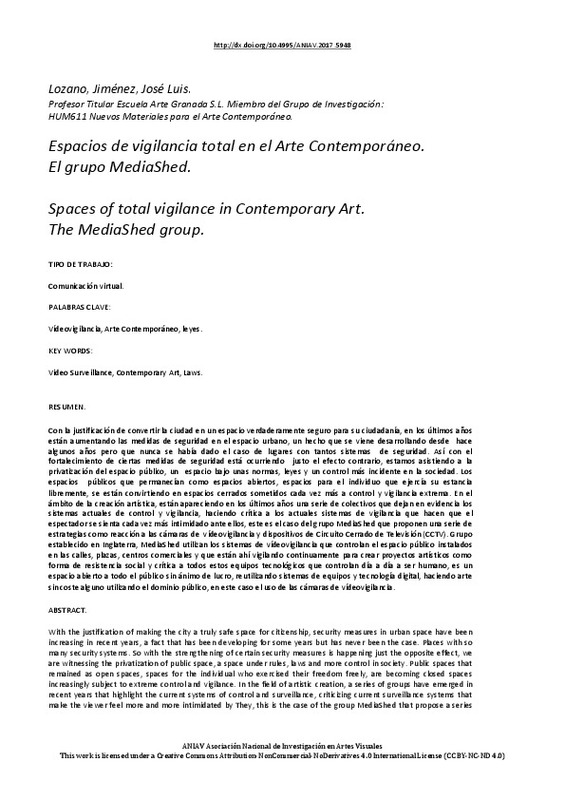JavaScript is disabled for your browser. Some features of this site may not work without it.
Buscar en RiuNet
Listar
Mi cuenta
Estadísticas
Ayuda RiuNet
Admin. UPV
Espacios de vigilancia total en el Arte Contemporáneo. El grupo MediaShed
Mostrar el registro sencillo del ítem
Ficheros en el ítem
| dc.contributor.author | Lozano Jiménez, Jose Luis
|
es_ES |
| dc.date.accessioned | 2018-09-05T07:32:05Z | |
| dc.date.available | 2018-09-05T07:32:05Z | |
| dc.date.issued | 2017-10-23 | |
| dc.identifier.isbn | 9788490485736 | |
| dc.identifier.uri | http://hdl.handle.net/10251/106602 | |
| dc.description.abstract | [EN] [ With the justification of making the city a truly safe space for citizenship, security measures in urban space have been increasing in recent years, a fact that has been developing for some years but has never been the case. Places with so many security systems. So with the strengthening of certain security measures is happening just the opposite effect, we are witnessing the privatization of public space, a space under rules, laws and more control in society. Public spaces that remained as open spaces, spaces for the individual who exercised their freedom freely, are becoming closed spaces increasingly subject to extreme control and the field of artistic creation, a series of groups have emerged in recent years that highlight the current systems of control and surveillance, criticizing current surveillance systems that make the viewer feel more and more intimidated by They, this is the case of the group MediaShed that propose a series of strategies like reaction to the cameras of videohsurveillance and devices of Closed Circuit Television (CCTV). Group established in England, MediaShed use the video surveillance systems that control the public space installed in the streets, squares, shopping centers and that are there continuously watching to create artistic projects as a form of social and critical resistance to all these technological equipment that control day A day to be human, is a space open to all public, reusing equipment systems and digital technology, making art at no cost using the public domain, in this case the use of video surveillance cameras. | es_ES |
| dc.description.abstract | [ES] Con la justificación de convertir la ciudad en un espacio verdaderamente seguro para su ciudadanía, en los últimos años están aumentando las medidas de seguridad en el espacio urbano, un hecho que se viene desarrollando desde hace algunos años pero que nunca se había dado el caso de lugares con tantos sistemas de seguridad. Así con el fortalecimiento de ciertas medidas de seguridad está ocurriendo justo el efecto contrario, estamos asistiendo a la privatización del espacio público, un espacio bajo unas normas, leyes y un control más incidente en la sociedad. Los espacios públicos que permanecían como espacios abiertos, espacios para el individuo que ejercía su estancia libremente, se están convirtiendo en espacios cerrados sometidos cada vez más a control y vigilancia extrema. En el ámbito de la creación artística, están apareciendo en los últimos años una serie de colectivos que dejan en evidencia los sistemas actuales de control y vigilancia, haciendo crítica a los actuales sistemas de vigilancia que hacen que el espectador se sienta cada vez más intimidado ante ellos, este es el caso del grupo MediaShed que proponen una serie de estrategias como reacción a las cámaras de videovigilancia y dispositivos de Circuito Cerrado de Televisión (CCTV). Grupo establecido en Inglaterra, MediaShed utilizan los sistemas de videovigilancia que controlan el espacio público instalados en las calles, plazas, centros comerciales y que están ahí vigilando continuamente para crear proyectos artísticos como forma de resistencia social y crítica a todos estos equipos tecnológicos que controlan día a día a ser humano, es un espacio abierto a todo el público sin ánimo de lucro, reutilizando sistemas de equipos y tecnología digital, haciendo arte sin coste alguno utilizando el dominio público, en este caso el uso de las cámaras de videovigilancia. | es_ES |
| dc.format.extent | 9 | es_ES |
| dc.language | Español | es_ES |
| dc.publisher | Editorial Universitat Politècnica de València | es_ES |
| dc.relation.ispartof | Glocal [codificar, mediar, transformar, vivir] III Congreso Internacional de Investigación en Artes Visuales | es_ES |
| dc.rights | Reconocimiento - No comercial - Sin obra derivada (by-nc-nd) | es_ES |
| dc.subject | Videovigilancia | es_ES |
| dc.subject | Arte contemporáneo | es_ES |
| dc.subject | Leyes | es_ES |
| dc.subject | Video surveillance | es_ES |
| dc.subject | Contemporary art | es_ES |
| dc.subject | Laws | es_ES |
| dc.title | Espacios de vigilancia total en el Arte Contemporáneo. El grupo MediaShed | es_ES |
| dc.title.alternative | Spaces of total vigilance in Contemporary Art. The MediaShed group | es_ES |
| dc.type | Capítulo de libro | es_ES |
| dc.type | Comunicación en congreso | es_ES |
| dc.identifier.doi | 10.4995/ANIAV.2017.5948 | |
| dc.rights.accessRights | Abierto | es_ES |
| dc.description.bibliographicCitation | Lozano Jiménez, JL. (2017). Espacios de vigilancia total en el Arte Contemporáneo. El grupo MediaShed. En Glocal [codificar, mediar, transformar, vivir] III Congreso Internacional de Investigación en Artes Visuales. Editorial Universitat Politècnica de València. 833-841. https://doi.org/10.4995/ANIAV.2017.5948 | es_ES |
| dc.description.accrualMethod | OCS | es_ES |
| dc.relation.conferencename | III Congreso Internacional de Investigación en Artes Visuales :: ANIAV 2017 :: GLOCAL | es_ES |
| dc.relation.conferencedate | Julio 06-07,2017 | es_ES |
| dc.relation.conferenceplace | Valencia, Spain | es_ES |
| dc.relation.publisherversion | http://ocs.editorial.upv.es/index.php/ANIAV/ANIAV2017/paper/view/5948 | es_ES |
| dc.description.upvformatpinicio | 833 | es_ES |
| dc.description.upvformatpfin | 841 | es_ES |
| dc.type.version | info:eu-repo/semantics/publishedVersion | es_ES |
| dc.relation.pasarela | OCS\5948 | es_ES |








